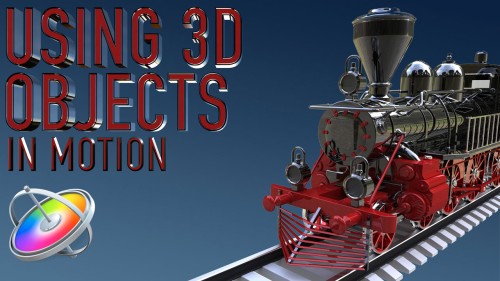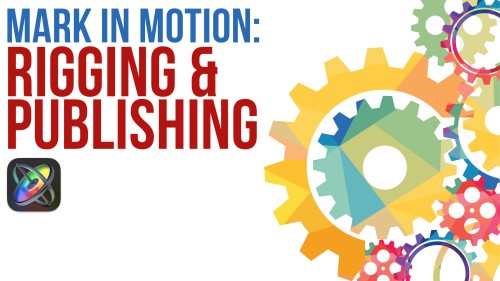- Learn all the basic Motion behaviors
- Harness the power of key Parameter behaviors
- When to use behaviors vs. keyframes
- How to choose the right Behavior
- Over 3 dozen projects included
The Point At Behavior
Behaviors create procedural animations without the need for keyframes. The Basic Motion and Parameter Behaviors are great general-purpose behaviors and you’ll learn which ones are the most useful. For example, Mark will show you how to use a Point At behavior to make one project element follow another element in your scene.
The Wriggle Behavior
Parameter behaviors allow you to control specific parameters of your animations such as an element’s opacity, scale, position, rotation and more. In one such example, you’ll learn how to use the Wriggle Parameter Behavior to give an object a frenetic look as it moves along a motion path.
The Rate Behavior
The Rate behavior is used to control the value of a given parameter over time. It has a number of use cases, and in this example, Mark demonstrates how you can use it to control the speed and direction of replicated objects placed along a path.
The Link Behavior
If you need to synchronize your parameter adjustments across multiple elements in your project, the Link behavior is a timesaver of epic proportion. In this example, you’ll learn how to link the rotation parameters of 3D text elements to create complex movements that would otherwise be too cumbersome to create using basic behaviors or keyframes.




Petter V. (verified owner) –
Yet, another great tutorial.
I learned a lot about parameter behaviours and was really inspired to explore many more of the behaviours.
My third Ripple tutorial so far and I feel that I have only scratched the surface of Final Cut Pro and Motion.
I guess there will be more tutorials for me 🙂
Paul K. (verified owner) –
Excellent modular tutorials in this course. Mark’s depth of knowledge is vast, and his explanations are clear.
Liron C. (verified owner) –
Another fantastic tutorial from Ripple Training!
You guys are the absolute best. Almost everything I know about FCPX and Motion, I’ve learned from you.
I had been hoping for a deeper dive into behaviors, as I knew there is so much more to Motion than I had managed to figure out for myself, and you didn’t disappoint! I’ve learned so much from your excellent teaching. Thank you, and I look forward to your next tutorial!
George S. (verified owner) –
One of the most mysterious aspects of Motion is parameter behavior. I had used one or two parameters before taking this tutorial but without much confidence in how they worked. Once again, Mark Spencer’s excellent presentation throughout the lessons left me without an excuse for not using them in my projects. In particular, in lesson 12, where he discusses the Overshoot parameter, he points out how it is responsible for adding the realistic “shake into place” feature of the dart hitting the dartboard. He also explains (and shows) that getting the shake right requires playing around with Ramp Duration and Cycles in the Overshoot inspector.
Another useful part of the tutorial was lesson 4, in which he uses the Move behavior to pan and scan a group photo of NASA astronauts. This is a feature of Motion I foresee using quite often.
As he does with all his tutorials, Mark repeats Motion fundamentals and shortcuts while narrating the details of the new features he’s presenting. Do you know what the Q shortcut key does? I do now.
Overall, if you’re serious about learning video editing and graphics animation, and how they can work together to provide an engaging movie, you will want to take as many Ripple tutorials as your mind and budget can absorb. Be sure to include this one in your selections.
Andre F. (verified owner) –
Bought it and love it!
Thanks guys.Andre
Raymond S. –
This looks to be an awesome tutorial. I have a huge interest in road map animation. Example; Animating a line on roads following it’s curves throughout a trip through different states. Also having drop zones for video along the way. Will this accomplish this? As always Mark, Thank You for all your awesome work you put into your tutorials. Ray
Tim D. (verified owner) –
I sat down on my own a few months ago and went through all the parameter behaviours and tried them all (well those I thought I understood) I got the gist of most of them but this tutorial put them in perspective, attached them to real world examples and explained them in a way only Mark can do… another succinct tutorial which pushes you to a new level in no time at all… thanks…
Peter E. (verified owner) –
Brilliant tutorial Mark, as always. Your tutorials always come with great practical examples and clear explanations. The downloadable projects and media behind the examples is an added bonus.
I especially liked the Audio Parameter Behaviour chapter. Going to have great fun with that one. More please…
Konstantin T. (verified owner) –
As soon as I have a question about using some features in Motion 5, a new lesson from Ripple Training comes out.This is some kind of magic! Thanks, Mark!
John K. (verified owner) –
Unbelievable! If I had been able to watch this two weeks ago it would have saved me hours of wasted time searching YouTube for how to do this very stuff. I have literally stumbled my way through these tools every time I try to use them. By Lesson 3 I have already learned more than I ever expected.
Every penny I spend with you guys pays back 100X.
Keep up the great work.
Thanks a ton.
John
Ed V. (verified owner) –
Dang! I already bought 14 FCP X and Motion Tutorials from you guys and it looks like this is going to be the 15th! Okay, I’m buying!
Learning from Mark and Steve just improved my workflow in a big way! Thank you guys for coming up with fantastic tutorials.